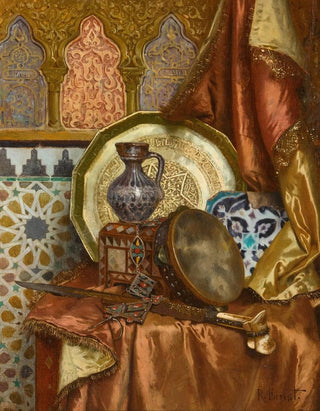Art print | A still life with Moroccan objects - Rudolf Ernst


View from behind

Frame (optional)
In the fascinating world of painting, some artworks transcend their era and transport us to distant horizons. "A Still Life with Moroccan Objects" by Rudolf Ernst is one of those creations that captivate through their visual richness and historical depth. This piece, created at the end of the 19th century, invites us to contemplate a carefully arranged assemblage of objects, evoking Moroccan culture with remarkable precision and delicacy. Light plays a crucial role in this composition, illuminating the textures and colors of the objects and creating a warm, welcoming atmosphere. By immersing ourselves in this still life, we are invited to explore not only the objects themselves but also the stories and traditions they carry.
Style and uniqueness of the work
Rudolf Ernst's style is distinguished by meticulous attention to detail and exceptional mastery of colors. In "A Still Life with Moroccan Objects," each element, whether a delicate pottery or a richly decorated textile, is treated with special care. The shades of blue, red, and gold intertwine harmoniously, creating a vibrant palette that evokes lively markets and souks of Morocco. The composition is balanced, each object finding its place in a silent dialogue with the others, forming a coherent and captivating scene. This painting does not merely depict objects; it tells a story, that of a cultural exchange between the East and the West, at a time when these interactions were flourishing.
The artist and his influence
Rudolf Ernst, an Austrian-born painter, managed to establish himself on the European art scene thanks to his unique talent for capturing the essence of Eastern cultures. His journey led him to travel across Morocco, where he was deeply inspired by the landscapes, colors, and textures he encountered. This immersion into Moroccan culture nourished his work, allowing him to create pieces that go beyond simple representation. Ernst skillfully integrated elements of the Orient into his art, influencing many contemporary and future artists. His ability to fuse Western technique with Eastern themes opened

Matte finish

View from behind

Frame (optional)
In the fascinating world of painting, some artworks transcend their era and transport us to distant horizons. "A Still Life with Moroccan Objects" by Rudolf Ernst is one of those creations that captivate through their visual richness and historical depth. This piece, created at the end of the 19th century, invites us to contemplate a carefully arranged assemblage of objects, evoking Moroccan culture with remarkable precision and delicacy. Light plays a crucial role in this composition, illuminating the textures and colors of the objects and creating a warm, welcoming atmosphere. By immersing ourselves in this still life, we are invited to explore not only the objects themselves but also the stories and traditions they carry.
Style and uniqueness of the work
Rudolf Ernst's style is distinguished by meticulous attention to detail and exceptional mastery of colors. In "A Still Life with Moroccan Objects," each element, whether a delicate pottery or a richly decorated textile, is treated with special care. The shades of blue, red, and gold intertwine harmoniously, creating a vibrant palette that evokes lively markets and souks of Morocco. The composition is balanced, each object finding its place in a silent dialogue with the others, forming a coherent and captivating scene. This painting does not merely depict objects; it tells a story, that of a cultural exchange between the East and the West, at a time when these interactions were flourishing.
The artist and his influence
Rudolf Ernst, an Austrian-born painter, managed to establish himself on the European art scene thanks to his unique talent for capturing the essence of Eastern cultures. His journey led him to travel across Morocco, where he was deeply inspired by the landscapes, colors, and textures he encountered. This immersion into Moroccan culture nourished his work, allowing him to create pieces that go beyond simple representation. Ernst skillfully integrated elements of the Orient into his art, influencing many contemporary and future artists. His ability to fuse Western technique with Eastern themes opened






